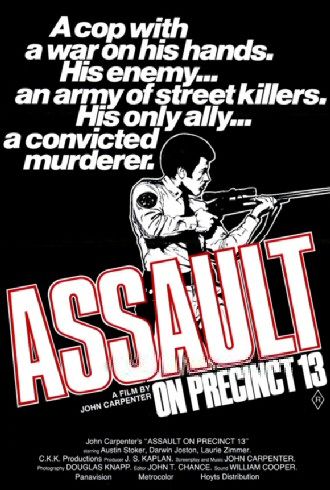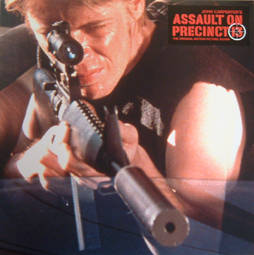- Assault on Precinct 13 (1976 film)
Infobox_Film
name = Assault on Precinct 13

caption = Original theatrical promotional poster.
imdb_id = 0074156
director =John Carpenter
writer =John Carpenter
starring =Austin Stoker Darwin Joston
producer = J.S. Kaplan
music =John Carpenter
cinematography = Douglas Knapp
distributor = CKK
released = flagicon|USANovember 5 ,1976
runtime = 91 min.
amg_id = 1:3126
country = USA
language = English"Assault on Precinct 13" is a 1976 American action/thriller movie inspired by the
Howard Hawks film Rio Bravo. It was written and directed byJohn Carpenter . The film tells of the fictional attack on a police precinct by the Street Thunder gang out for retribution for the death of their comrades. The film received mixed reviews with an unimpressive box office return. However, it went on to receive tremendous critical and popular acclaim in the UK and Europe.Plot
A rundown neighborhood in South Central
Los Angeles , known as the "Anderson ghetto", is filled with street gangs and thugs. Members of a local gang, calledStreet Thunder , have recently stolen a large number of automatic rifles. Consequently, theL.A.P.D. sends a team of heavily armed officers to ambush and kill six members of the gang. Following this attack, the four gang warlords swear a blood oath of revenge, known as a "Cholo", against the police and the citizens of Los Angeles.On the same day that the Street Thunder members swear revenge, one of the Anderson police stations, Precinct 9, Division 13, is about to close down. The old police station is running on a skeleton staff composed only of officer Chaney and the station's two secretaries, Leigh (
Laurie Zimmer ) and Julie (Nancy Loomis ). Lieutenant Ethan Bishop (Austin Stoker ), a newly promotedCalifornia Highway Patrol officer, is assigned to run the station for its last few hours of service, even though this assignment falls outside the usual scope of his duties as a CHP officer.Meanwhile, a man named Lawson (Martin West) is driving through a nearby area with his young daughter, Kathy (
Kim Richards ), searching for the street where her nanny lives. Frustrated, he stops to call the nanny at a public telephone booth. While Lawson is on the phone, his daughter goes to buy an ice-cream from a nearby truck. Unseen, the Street Thunder warlords approach, and one of them shoots Kathy and the ice-cream vendor, killing the little girl instantly and fatally wounding the man. With his dying breath, the ice-cream vendor tells a distraught Lawson that there is a gun under the ice-cream truck's dashboard. Taking the gun, Lawson pursues the four gang leaders into the Anderson area and kills the one who shot his daughter. At a loss for what to do next, he goes to a nearby phone booth, but then sees he is being pursued by the remaining warlords and other gang members. Seeking shelter, he runs into the nearly deserted police station. In shock, Lawson cannot communicate what has happened to him.Around the same time, three prisoners are being transferred by bus from one penitentiary to another facility several hours away, when one prisoner becomes increasingly ill. Starker (
Charles Cyphers ), the officer in charge of transporting the prisoners, decides to get medical assistance. He tells the bus driver to pull over at the nearest safe location, which happens to be Bishop's station. The prisoners,Napoleon Wilson (Darwin Joston ), a convicted killer on his way toDeath Row , Wells (Tony Burton ), and the sick Caudell (Peter Frankland), are put into the holding cells while Starker attempts to call a doctor. The telephone lines suddenly go dead, and Starker, frustrated by his inability to get help, prepares to put the prisoners back on the bus.The street gang, armed with heavy weapons such as the Colt M16, suddenly open fire on the precinct. In a matter of seconds, they kill Chaney (Henry Brandon), the bus driver, Caudell, Starker, and the two uniformed officers assigned to support Starker during the prisoner transfer. While bullets fly, Wells rushes back into the station and Bishop rescues Wilson, who is chained to (and trapped under) Starker's body. Bishop then puts Wilson and Wells back into the holding cells.
The gang, having already cut the telephone lines, then cut the station's electricity. Three gang members come forward to break a blood-filled bowl symbolizing the Cholo on the precinct's front steps, formally signifying that a siege is underway. Heavily outnumbered, without options, and once again under attack as the gang members resume shooting, Bishop sends Leigh down to the holding cells to release Wells and Wilson, who then take up arms. A battle rages as gang members launch a suicidal attack on the station in a crazed attempt to kill all inside. Wilson, Bishop, Wells, and Leigh successfully defend the station, but Julie is gunned down in the ensuing chaos.
After the gun battle, the gang members quickly remove all evidence of the skirmish and appear to momentarily retreat. Wilson, Bishop, Leigh, and Wells then decide that one person should try to sneak out of the station, hot-wire a car outside, and drive away to summon help. Since Leigh has a wounded arm, and Bishop does not know how to hot-wire a car, Wilson and Wells play a game of "potatoes" to decide who will go. Wells loses. Although Wells appears to accomplish his task, he is shot and killed by a gang member hiding in the back seat of the car.
As the gang rally for a third time, Wilson, Leigh, and Bishop go down to the basement, taking the still-catatonic Lawson with them, and stage a "last stand". This culminates in Bishop shooting an
acetylene tank, which explodes violently, killing the gangsters inside the station. Police back-up arrives and secures the station, relieving the four survivors of the siege: Bishop, Leigh, Wilson, and Lawson.Production
Working within the limitations of a $100,000 budget, [ [http://www.imdb.com/title/tt0074156/business IMDb.com Business Data for Assault on Precinct 13 (1976)] ] Carpenter assembled a main cast that consisted mostly of experienced but relatively obscure actors. The two leads were Austin Stoker, who had appeared previously in science fiction, disaster and
blaxploitation films, and Darwin Joston, who had worked primarily in television and was also Carpenter's next-door neighbor. Q & A session with John Carpenter and Austin Stoker at American Cinematheque's 2002 John Carpenter retrospective, in the 2003 special edition DVD of "Assault on Precinct 13".]In addition to writing, directing, and scoring the film, John Carpenter also edited it using the pseudonym John T. Chance, the name of John Wayne's character in "Rio Bravo", for his editing credit. Carpenter also employed the John T. Chance pseudonym for his original version of "The Anderson Alamo" script, but he used his own name for the writing credit on the completed film. Still Gallery feature, included in the 2003 special edition DVD of "Assault on Precinct 13".]
The most infamous scene in the movie is the one in which a gang member deliberately shoots and kills a little girl standing near an ice-cream truck. The
MPAA threatened to give the film an X-rating if the scene wasn't cut. Following the advice of his distributor, Carpenter gave the appearance of complying by cutting the scene from the copy he gave to the MPAA, but he distributed the film with the "ice cream truck" scene intact. (No real guns or bullets were used in the scene where the child is shot; the production team simply placed an air hose in the little girl's ice cream cone, and used it to blow colored liquid onto her to simulate a "gunshot.")Although the film's title is "Assault on Precinct 13", the action mainly takes place in a police station referred to as Precinct 9, Division 13, by Bishop's staff sergeant over the radio.
The film's distributor was responsible for the misnomer. John Carpenter originally called the film "The Anderson Alamo", and, at one point, he briefly changed the title to "The Siege". During post-production, however, the distributor rejected Carpenter's title in favor of the film's present name. The moniker "Precinct 13" was used in order to give the new title a more ominous tone.
Reception
The film was originally released in the United States in 1976 to mixed critical reviews and unimpressive box office earnings. The following year, however, it was screened at the 21st
London Film Festival , where it was one of the festival's best-received films and garnered tremendous critical and popular acclaim. The overwhelmingly positive British response to the film led to its critical and commercial success throughout Europe. Subsequently, the film underwent a reassessment by American critics and audiences, and it is now generally considered one of the best action films of the 1970s. John Carpenter has said that the British audiences immediately understood and enjoyed the film's similarities to American westerns, whereas American audiences were too familiar with the western genre to fully appreciate the movie at first.Fact|date=March 2008oundtrack
Infobox Album |
Name = Assault on Precinct 13
Type = Soundtrack
Artist =John Carpenter

Released = 2003
Recorded = 1976
Genre = ElectronicFilm score
Length = 24:36
Label = Record Makers
Producer =
Reviews = One of the film's features is its score, composed and recorded by directorJohn Carpenter . The combination of synthesizer hooks, electronic drones and drum machines set it apart from many other scores of the period and created a distinct style of minimalist electronic soundtrack for which Carpenter, and his films, would become associated. The score consists of two main themes: the main title theme, with its familiar synthesizer melody, and a slower more contemplative theme used in the film's more subdued scenes. Besides these two themes the soundtrack also features a series of ominous drones and primal drum patterns which often represented the anonymous gang gathering in the shadows.Beyond its use in the film, the score is often cited as an influence on various electronic and hip hop artists with its main title theme being sampled by artists including
Afrika Bambaataa ,I-F ,Dead Prez andBomb the Bass , whose song "Megablast" featured a sample of the score and was used in the soundtrack to the video gameXenon 2 Megablast . A new cover of the theme called "Precinct 13" was released by Tape Recording Club in November 2006.Fact|date=March 2008 UK punk band "The Exploited " also utilized the main theme as a bass riff in the song "Don't Blame Me", which appears on their 1996 album "Beat the Bastards ".Despite this influence, except for a few compilation appearances, the film's score remained available only in bootleg form until 2003 when it was given an official release through the French label, Record Makers.Fact|date=March 2008
Track listing
#"Assault On Precinct 13 (Main Title)"
#"Napoleon Wilson"
#"Street Thunder"
#"Precinct 9 - Division 13"
#"Targets / Ice Cream Man On Edge"
#"Wrong Flavour"
#"Emergy Stop"
#"Lawson's Revenge"
#"Sanctuary"
#"Second Wave"
#"The Windows!"
#"Julie"
#"Well's Flight"
#"To The Basement"
#"Walking Out"
#"Assault On Precinct 13"ee also
*
1976 in film
*"Assault on Precinct 13 (2005 film) "
*"The Nest " ("Nid de guêpes")References
External links
*imdb title|id=0074156|title=Assault on Precinct 13
*http://www.theofficialjohncarpenter.com/pages/themovies/ap/apmm.html - Official John Carpenter website
Wikimedia Foundation. 2010.
